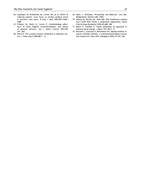/


Sax B Allegranzi IUc 57528kay E Larson J Boyce D Pittet Infection Control Programme University of Geneva Hospitals Geneva Switzerland Global Patient Safety Challenge World Alliance for Patient Safety World Health Organization Geneva Switzerland S ID: 25779
Download Pdf The PPT/PDF document "REVIEW My ve moments for hand hygiene a ..." is the property of its rightful owner. Permission is granted to download and print the materials on this web site for personal, non-commercial use only, and to display it on your personal computer provided you do not modify the materials and that you retain all copyright notices contained in the materials. By downloading content from our website, you accept the terms of this agreement.
My vemomentsforhandhygiene:auser-centreddesignapproachtounderstand,train,monitorandreporthandhygieneH.Sax,B.Allegranzi,I.Uc¸kay,E.Larson www.elsevierhealth.com/journals/jhin bridgesthegapbetweenscienti cevidenceanddailyhealthpracticeandprovidesasolidbasistounderstand,teach,monitorandreporthandhy-gienepractices.2007TheHospitalInfectionSociety.PublishedbyElsevierLtd.Allrightsreserved.Healthcare-associatedinfections(HCAIs)repre-sentamajorrisktopatientsafetyandcontributetowardssuffering,prolongationofhospitalstay,costandmortality.HandhygieneisthecoreelementtoprotectpatientsagainstHCAIsandcol-onisationwithmulti-resistantmicro-organisms.Cleansinghandswithalcohol-basedhandrubisasimpleandundemandingprocedurethatrequiresonlyafewseconds.Ifhandrubiseasilyavail-ableateachpointofcare,handhygienecanalsoeasilybeintegratedinthenaturalwork oweveninhigh-densitycaresettings.However,mosthealthcareworkers(HCWs)practicehandhygienelessthanhalfasoftenastheyshould.Reasonsforneglectinghandhygienehavebeeninvestigatedandincludeforgetfulness,fearofskindamage,lackoftimeduetootherpatientcarepriorities,andscarceorinconvenientaccesstohandrubandsinks.However,oneessentialel-ementisfrequentlyoverlooked:thequalityoftheinformationandtrainingdispensedtoHCWstoex-plainwhy,whenandhowtoapplyhandhygieneduringroutinecareactivity.Yet,thereisaccumu-latingevidencethatfailuretocomplywithgoodpracticeisoftenduetopoordesign,whetheritbedevice-related,humanmachineinterfacesor,importantly,processdesign.Thisincludesmisleadinglanguage,complicateddescriptions,orpoorde nitionoftargetoutcomes.Severaldisciplinessuchashumanfactorsengi-neeringandergonomics,socialmarketing,peda-gogy,andcommunicationsciencehavebeenfoundtobehelpfulinbridgingthegapbetweenscienti cliteratureanduser-centred,error-proofproductsandprocesses.Whenmeasuredagainstthesestandards,theconceptofhandhygienehasbeenpoorlyassessedfromtheseperspectivesuntilnow.Eveninfectioncontrolexpertshavedif cul-tiesinreachingaconsensusontherelativerisklevelsofdifferentcareactivitiesandhowtobestde nekeymomentsforhandhygieneaction.BuildingonthelongstandingexperienceattheUniversityofGenevaHospitalsandworkontooldevelopmentintheframeworkoftheSwissna-tionalhandhygienecampaignandtheWHOGlobalPatientSafetyChallengeCleanCareisSaferCare,wedevelopedauser-centredconceptforrecognisingwhenhandhygieneshouldbedone,aswellastraining,performanceassessmentandreporting.Wedescribeherethedesignprocessoftheconcept,therationaleforelementsincluded,anditspotentialpracticaluse.RequirementsanddevelopmentRequirementspeci cationsforauser-centredhandhygieneconceptThemainspeci cationsfortheconceptaregivenTableI.Importantly,itmustresultinaminimalcomplexityanddensityofhandhygieneactions,integratewellintoanaturalwork ow,butstillat-tainamaximumpreventiveeffect.Forapplicabil-ityacrossawiderangeofcaresettingsandhealthcareprofessions,itmustalsocreateauni- edapproachwithoutlosingthenecessarydetailtoproducemeaningfuldataforriskanalysisandfeedback.Theconceptshouldbeabsolutelycongruentindesignandmeaningtotrainers,observersandtheobservedHCWs.Thishasthedualpurposeofavoidinganylackofclaritybyanexpertpersongapandtocutdownontrainingtimerequirementandexpenditure.Moreover,thesharingofauni edvisionshouldleadtoastrongsenseofownership.Additionally,conceptrobust-nessisequallyinstrumentalbothtoavoidinter-observervariationandtoguaranteeintra-hospital, TableIRequirementspeci cationsforauser-centredhandhygieneapplicationconceptConsistentwithevidence-basedriskassessmentofhealthcare-associatedinfectionsandspreadofmulti-resistantmicro-organismsStealthintegrationintoanaturalcarework owEasytolearnLogicalclarityoftheconceptApplicableinawiderangeofhealthcaresettingsMinimisingthedensityoftheneedforhandhygieneMaximalconceptcongruencebetweentrainers,observers,andhealthcareworkers H.Saxetal. inter-hospitalandinternationalcomparisonsandcommunication.Finally,characteristicsknowntoneurosciencetoincreaselearningandfacilitateuptakesuchaslimitednumberofitems,clusteringofitems,sym-metry,rhythm,plainandmeaningfulterminology,colourcodes,clarityandlogic,highsignal-to-noiseratio,andcorrespondencetopre-existingconceptsintheconcernedpopulationwereappliedduringthedesignprocesswheneverpossible.Healthcare-associatedcolonisationandinfection:thenegativeoutcometargetsForconceptualclarity,itisusefultorevisittwodistinctoutcomesoftransmissionpathways.Colo-nisationdenotesthepresenceofmicro-organismsonbodysiteswithoutinvadingthetissueandwithouttriggeringasymptomatichostdefencereaction;infectiondenotestissueinvasionofmicro-organismstriggeringanin ammatoryhostresponse.Transmissionofmicro-organismsfromthehealth-careenvironment(e.g.furniture,equipment,walls,doors,documents,neighbouringpatients,etc.)toapatientmostoftenresultsincross-colonisationandnotininfection.38,39Cross-colonisationwithmulti-resistantmicro-organismsrepresentsanimportanttargetforpreventionbecauseitcontributestoin-creasingantimicrobialresistanceandthereservoirofpotentialpathogens.40,41Withrespecttocross-colonisation,itisimpor-tanttorecognisethreefacts: rst,colonisedorinfectedpatientsrepresentthemainreservoirforhealthcare-associatedmicro-organisms;second,theenvironmentinthehealthcarefacilitycontainsawidevarietyofdifferenthealthcare-associatedmicro-organismsandrepresentsasecondarysourcefortransmission;andthird,theimmediatepatientenvironmentbecomescolonisedbythepatient ora.Cross-transmissioncanresultinexogenousHCAI,inparticularifthepatientsdefenceagainsttheimplicatedmicro-organismisloworifitisdirectlyintroducedintoavulnerablebodysite,ormucousmembrane.MostHCAIs,however,areofanendogenousnature,andduetomicro-organismsalreadycolo-nisingthepatientbeforetheonsetofinfec-Thisimpliesthathandsmayplayaroleinthisprocessbytransferringmicro-organismsfromacolonisedbodysitetoacleanoneinthesamepatient,e.g.fromtheperineumtoatrachealtube,orfromthelegskintoacatheterhub.inducedbreaksofphysicalandbiologicaldefencemechanismsbyinvasiveproceduresanddevicesrepresentriskfactorsforinfection.Inadditiontopatientcolonisationand/orinfec-tion,twoadditionalnegativeoutcomesaretargetedbyhandhygiene:infectioninHCWswithpathogenscontainedinbody uidsandcross-colonisationofinanimateobjectsinthehealthcareenvironmentandcolonisationofHCWsbypatient ora.Insummary,fournegativeoutcomesconstitutethepreventiontargetforhandhygiene:(i)cross-colonisationofpatients;(ii)endogenousandex-ogenousinfectioninpatients;(iii)infectioninHCWs;and(iv)cross-colonisationofthehealthcareenvironmentincludingHCWs.ThecoreelementofhandtransmissionDuringdailypractice,HCWshandstypicallytouchacontinuoussequenceofsurfacesandsubstancesincludinginanimateobjects,patientsintactornon-intactskin,mucousmembranes,food,waste,body uidsandtheHCWsownbody.Thetotalnumberofhandexposuresinahealthcarefacilitymightreachasmanyasseveraltensofthousandsperday.Witheachhand-to-surfaceexposureabidirec-tionalexchangeofmicro-organismsbetweenhandsandthetouchedobjectoccursandthetransienthand-carried oraisthuscontinuouslychanging.Inthisway,micro-organismscanspreadthroughoutahealthcareenvironmentwithinafewhours.Anevidence-basedhandtransmissionmodelhasbeendescribedelsewhere.Inbrief,weillus-tratethecoreelementsstrippeddowntotheirsimplestlevelinFigure1.Effectivehandcleansingcanpreventtransmissionofmicro-organismsfromsurfaceAtosurfaceBifappliedatanymomentduringhandtransitionbetweenthetwosurfaces.Typically,surfaceAcouldbeadoorhandlecolon-isedbymeticillin-resistantStaphylococcusaureus(MRSA)andsurfaceBtheskinofapatient.Iftrans-missionofmicro-organismsbetweenAandBwouldresultinoneofthefournegativeoutcomesde-tailedabove,thecorrespondinghandtransitiontimebetweenthesurfacesisusuallycalledahandhygieneopportunity.Ifavoidable,nottouchingAorBorbothwouldbeanotherveryef-fectivewayofpreventingcross-contaminationandinfection.TouchingtwiceinarowsurfaceBwouldequallynotgenerateaneedforhandhygiene.Hence,itfollowsclearlythatthenecessityforhandhygieneisde nedbyacoreelementofhandtransmissionconsistinginadonorsurface,areceptorsurfaceandhandtransitionfromthe rsttothesecond.Merelydescribingahandhy-gieneopportunityasamomentbeforeexecutingacertaincaretaskisanoversimpli cationandwillbediscussedinafurthersection. My vemomentsforhandhygiene11 Conceptualisationoftherisk:twozones,twocriticalsitesToachievetheobjectiveofcreatingauser-centredconcept,weoptedforadirecttranslationoftheevidence-basedhandtransmissionmodeldescribedabovetoapracticaldescriptionofhandhygieneindications.Thetermszoneandcriticalsiteswereintroducedtoallowageographicalvisual-isationofkeymomentsforhandhygiene(Figure2Focusingonasinglepatient,thehealthcaresettingisdividedintotwovirtualgeographicalareas,thepatientzoneandthehealthcarezoneFigure2AandB).ThepatientzonecontainsthepatientXandhis/herimmediatesurroundings.Thistypicallyin-cludestheintactskinofthepatientandallinanimatesurfacesthataretouchedbyorindirectphysicalcontactwiththepatientsuchasthebedrails,bedsidetable,bedlinenandinfusiontubingandothermedicalequipment.ItfurthercontainssurfacesfrequentlytouchedbyHCWswhilecaringforthepatientsuchasmonitors,knobsandbuttons,andotherhighfrequencytouchsurfaceswithinthepatientzone.Themodelassumesthatthepatient orarapidlycontaminatestheentirepatientzone,butthatitisbeingcleanedbetweenpatientadmissions.ThehealthcarezonecontainsallsurfacesoutsidethepatientzoneofpatientX,i.e.allotherpatientsandtheirpatientzonesandthehealthcarefacilityenvironment.Conceptually,thehealthcarezoneiscontaminatedwithmicro-organismsthatmightbeforeignandpotentiallyharmfultopatientX,eitherbecausetheyaremulti-resistantorbecausetheirtransmissionmightresultinexogenousinfection. Figure1Coreelementofhandtransmission.(1)DonorsurfaceAcontainsmicro-organismsa;receptorsurfaceBmicro-organismsb.(2)Ahandpicksupamicro-organismafromdonorsurfaceAandcarriesitovertoreceptorsurfaceB,nohandhygieneactionperformed.(3)ReceptorsurfaceBisnowcross-contaminatedwithmicro-organismainadditiontooriginal orab.Thearrowmarkstheopportunityforhandhygiene,e.g.thetimeperiodandgeographicaldislocationwithinwhichhandhygienewillpreventcross-transmission;theindicationsforhandhygienearedeterminedbytheneedtoprotectsurfaceBagainstcolonisationwithathepreventablenegativeoutcomeinthisexample. H.Saxetal. PATIENT ZONEHEALTHCARE ZONEPATIENTCONTACTPATIENTCONTACTCONTACTS WITHPATIENTSURROUNDINGSTASKAFTER BODY FLUID Figure2Uni edvisualsforMy vemomentsforhandhygiene.Patientzonede nedasthepatientsintactskinandhis/herimmediatesurroundingscolonisedbythepatient oraandhealthcarezonecontainingallothersurfaces.(A)Symbolsforcleansiteandbody uidsite,twocriticalsitesforhandhygienewithinthepatientzone.(B)ZonesandsiteswithinsertedtimespacerepresentationofMy vemomentsforhandhygiene. My vemomentsforhandhygiene13 Withinthepatientzone,twocriticalsitesshouldbedistinguished(Figure2A):cleansitescorre-spondingtobodysitesormedicaldevicesthathavetobeprotectedagainstmicro-organismspo-tentiallyleadingtoHCAIs,andbody uidsiteslead-ingtohandexposuretobody uidsandblood-bornepathogens.Criticalsitesmayco-exist:drawingbloodforexamplewouldresultinacleansiteandabody uidsiteatthesametimeatthesiteofneedleperforationoftheskin.Theaddedvalueofcriticalsitesliesintheirpotentialuseinvisualmaterialandtraining:risk-pronetasksbecomegeographicallylocatedandhencemorepalpable.TheconceptanditspracticalMy vemomentsforhandhygieneThegeographicalrepresentationofthetwozonesandthetwocriticalsites(Figure2A)isusefultoin-troducethe vemomentsforhandhygiene.Thecorrelationbetweenthese vemomentsandtheindicationsforhandhygieneaccordingtoWHOGuidelinesonHandHygieneinHealthcaregiveninTableII.Tofurtherfacilitateeaseofrecallandexpandtheergonomicdimension,the vemo-mentsforhandhygienearenumberedaccordingtothehabitualcarework ow(Figure2Moment1:BeforepatientcontactFromthetwo-zoneconcept,amajormomentforhandhygieneisnaturallydeduced.Itoccursbetweenthelasthand-to-surfacecontactwithanobjectbelongingtothehealthcarezoneandthe rstwithinthepatientzonebestvisualisedbycrossingthevirtuallinebetweenthetwozones.Handhygieneatthismomentwillmainlypreventcross-colonisationofthepatientand,occasionally,exogenousinfection.Aconcreteexamplewouldbethetemporalperiodbetweentouchingthedoorhandleandshakingthepatientshand:thedoorhandlebelongstothehealthcarezoneandthepatientshandtothepatientzone.Moment2:BeforeanaseptictaskOncewithinthepatientzone,usuallyafterahandexposuretothepatientsintactskin,clothesoranyotherobject,theHCWmightengageinanaseptictaskonacleansitesuchasopeningavenousaccessline,givinganinjection,orperformingwoundcare.Importantly,handhygienerequiredatthismomentaimsatpreventingcolonisationandHCAI.Inlinewiththepredominantlyendogenousaetiologyoftheseinfections,handhygieneistakingplacebetweenthelastexposuretoasurface,evenwithinthepatientzoneandimmediatelybeforeaccesstoacleansite.ThisisimportantbecauseHCWscustomarilytouchanothersurfacewithinthepatientzonebeforecontactwithacleansite.Forsometasksoncleansites,e.g.lumbarpuncture,surgicalprocedures,trachealsuction-ing,etc.,theuseofglovesisstandardprocedure.Inthiscase,handhygieneisrequiredbeforedonningglovesbecauseglovesalonemaynotpreventcontaminationentirely.Moment3:Afterbody uidexposureriskAfteracaretaskassociatedwitharisktoexposehandstobody uids,e.g.afteraccessingabody uidsite,handhygieneisrequiredinstantlyandmusttakeplacebeforeanyhand-to-surfaceexpo-sure,evenwithinthesamepatientzone.Thishasadoubleobjective.Firstandmostimportantly,itreducestheriskofcolonisationorinfectionofHCWswithinfectiousagentswhichcanoccurevenintheabsenceofvisiblesoiling.Second,itreducestheriskofatransmissionofmicro-organismsfromacolonisedtoacleanbodysitewithinthesamepatient.Thisroutinemomentforhandhygieneconcernsallcareactionsassociatedwithariskofbody uidexposureandisnotidenticaltothehopefullyveryrarecaseofaccidentalvisiblesoil-ingcallingforimmediatehandwashing.cleansitescoincidewithbody uidsites(TableIIDisposableglovesaremeanttobeusedasasecondskintopreventexposureofhandstobody uids.However,handsarenotsuf cientlyprotectedbyglovesandhandhygieneisstronglyrecommendedaftergloveremoval.Evenifgloveremovalrepresentsastrongcuetohandhygieneac-tion,theconceptchoosestoidentifythismomentforhandhygienewiththeassociatedrisk(e.g.ex-posuretobody uids)ratherthanwiththeaddi-tionalprotectiveaction(e.g.gloveuse).Thishasthedoubleadvantageofbeingmoreconsistentwiththerisk-drivenlogicoftheoverallconceptandtocoveralltimeswhenglovesarenotworn.Moment4:AfterpatientcontactAfteracaresequence,whenleavingthepatientzoneandbeforetouchinganobjectinthehealth-carezone,handhygieneactionsubstantiallyre-ducescontaminationofHCWshandswiththe ora H.Saxetal. TableIIMy vemomentsforhandhygiene:explanationsandlinktoevidence-basedrecommendationsMomentEndpointsofhandPreventedExamplesLinktoWHOGuidelinesforHandHygieneinHealthCareWHOrecommendation(rankingforscienti c1BeforeDonorsurface:anysurfaceinthehealthcarezone.Patientcross-rarelyexogenousShakinghands,helpingapatienttomovearound,gettingwashed,takingpulse,bloodpressure,chestauscultation,abdominalpalpationBeforeandaftertouchingpatients(IB)Thetwomomentsbeforeandaftertouchingapatientwereseparatedbecauseoftheirspeci csequentialoccurrenceinroutinecareandunequalnegativeoutcomeincaseoffailuretoadhere,andusualadherencelevel.Receptorsurface:anysurfaceinthepatientzone2BeforeDonorsurface:anyothersurfacePatientinfection;rarelyOral/dentalcare,secretionaspiration,skinlesioncare,wounddressing,subcutaneousinjection;catheterinsertion,openingavascularaccesssystem;preparationoffood,medication,dressingsetsBeforehandlinganinvasivedeviceforpatientcare,regardlessofwhetherornotglovesareused(IB)Thisconceptwasenlargedtocoveralltransferofmicro-organismstovulnerablebodysitespotentiallyresultingininfection.Receptorsurface:cleansiteIfmovingfromacontaminatedbodysitetoacleanbodysiteduringpatientcare(IB)Sinceitisnotpossibletodeterminethesebodysitesobjectively,thisindicationwasnotretainedasaseparateitem,butcoveredbywithin-patient-zonemoments.3AfterbodyDonorsurface:body uidsiteworkerinfectionOral/dentalcare,secretionaspiration;skinlesioncare,wounddressing,subcutaneousinjection;drawingandmanipulatingany uidsample,openingdrainingsystem,endotrachealtubeinsertionandremoval;clearingupurines,faeces,vomit,handlingwaste(bandages,napkin,incontinencepads),cleaningofcontaminatedandvisiblysoiledmaterialorareas(lavatories,medicalAfterremovinggloves(IB)Afterbody uidexposureriskcoversthisrecommendation;seetextforfurthercomments.Receptorsurface:anyothersurfaceAftercontactwithbody uidsorexcretions,mucousmembranes,non-intactskin,orwounddressings(IA)Thisriskwasgeneralisedtoincludealltasksthatcanpotentiallyresultinhandexposuretobody uids.Aparadoxofbody uidexposurewasresolvedbyincludingthenotionofexposureriskinsteadofactualIfmovingfromacontaminatedbodysitetoacleanbodysiteduringpatientcare(IB)Seecomment(2)Beforeasepticcontinuedonnextpage My vemomentsforhandhygiene15 TableIIMomentEndpointsofhandPreventedExamplesLinktoWHOGuidelinesforHandHygieneinHealthCareWHOrecommendation(rankingforscienti c4AfterpatientDonorsurface:anysurfaceinthepatientzonewithtouchingapatient.workercross-Shakinghands,helpingapatienttomovearound,gettingwashed,takingpulse,bloodpressure,chestauscultation,abdominalpalpationBeforeandaftertouchingpatients(IB)Seecomment(1)BeforepatientReceptorsurface:anysurfaceinthehealthcarezone5AftercontactwithpatientDonorsurface:anysurfaceinthepatientzonethepatient.workercross-Changingbedlinen,perfusionspeedadjustment,monitoringalarm,holdingabedrail,clearingthebedsidetableAftercontactwithinanimateobjects(includingmedicalequipment)intheimmediatevicinityofthepatient(IB)RetainedtocoverallsituationswherethepatientsimmediateandpotentiallycontaminatedenvironmentistouchedbutnottheReceptorsurface:anysurfaceinthehealthcarezoneRankingsystemforevidenceaccordingtoWHOguidelines:categoryIA,stronglyrecommendedforimplementationandstronglysupportedbywell-designedexperimental,clinical,orepidemiologicalstudies;categoryIB,stronglyrecommendedforimplementationandsupportedbysomeexperimental,clinical,orepidemiologicalstudiesandastrongtheoreticalrationale. H.Saxetal. frompatientX,minimisestheriskofdisseminationtothehealthcareenvironment,andprotectstheHCWsthemselves.ItisnoteworthythatHCWsusuallytouchanobjectwithinthepatientzoneandnotthepatientbeforeleaving.Hence,thetermafterpatientcontactissomewhatmislead-ingandshouldbeunderstoodasaftercontactwiththepatientorhis/herimmediatesurroundings.Moment5:AftercontactwithpatientThe fthmomentforhandhygieneisavariantofmoment4.Itoccursafterhandexposuretoanysurfaceinthepatientzonebutwithouttouchingthepatient.Thistypicallyextendstoobjectscontaminatedbythepatient orathatareex-tractedfromthepatientzonetobedecontami-natedordiscarded.Becausehandexposuretopatientobjectswithoutphysicalcontactwiththepatientsisassociatedwithhandcontamination,handhygieneisrequired.CoincidenceoftwomomentsforhandTwomomentsforhandhygienemaysometimesfalltogether.Typicallythisoccurswhengoingfromonepatienttoanotherwithouttouchinganysurfaceoutsidethecorrespondingpatientzones.Naturally,asinglehandhygieneactionwillcoverthetwomomentsforhandhygiene.PracticalapplicationsofthemodelAmulti-modalapproachtohandhygienepro-motionhasbeenfoundtobethemostef cienttechniquetoincreasepatientsafetyinasustainedway.Arobustdescriptionofthecriticalmomentsforhandhygieneisimportantforthevariouselementsofamulti-modalstrategyin-cludingtraining,workplacereminders,ergonomiclocalisationofhandrubatthepointofcare,per-formanceassessmentbydirectobservations,andreporting.UnderstandingandvisualsAcriticalfeaturetofacilitatetheunderstandingandcommunicationofMy vemomentsforhandhygieneliesinitsstrongvisualmessage(Figure2Theobjectivewastorepresenttheever-changingsituationsofcareintopictogramsthatcouldserveawidearrayofpurposesandhealthcaresettings.Themodeldepictsasinglepatientinthecentreofauni edvisualtorepresentthepointofcareofanytypeofpatient.Thezones,criticalsitesandmomentsforhandhygieneactionarearrangedaroundthispatienttodepicttheinfectiousrisksandthecorrespondingmomentsforhandhygieneactionintimeandspace.TrainingThereareimportantinterpersonaldifferencesinthemosteffectivelearningstyles.Someindivid-ualsrespondbettertoconceptualgroupingandwillrespondwelltotherisk-basedconstructofzonesandcriticalsitesandthe vemomentsforhandhygiene.Formost,however,therationalbackgroundofaconceptisastrongmotivator.Itisthushelpfultomakeveryclearthereasonforeachofthe vemomentsforhandhygiene(TableIIOthersrespondbettertocircumstantialcuesanditisusefultolistthemostfrequentexamplesoc-curringinthespeci ccaresetting.Theapproachalsooffersmanypossibilitiesforthedevelopmentoftrainingtools,includingon-siteaccompaniedlearningkits,computer-assistedlearning,andoff-sitesimulators.Directobservationisthegoldstandardtomonitorcompliancewithoptimalhandhygienepractice.The ve-momentsmodelcanbeinstrumentalinseveralways.Manycareactivitiesdonotfollowastandardoperatingprocedure.Thus,itisdif culttode nethecrucialmomentforhandhygiene.Theconceptlaysareferencegridovertheseactiv-itiesandminimisesinter-observervariation.OnceHCWsarepro cientintheconcept,theyareabletobecomeobserverswithminimaladditionaleffort,thuscuttingdownontrainingcosts.Furthermore,theconceptsolvesthetypicalprob-lemsofclearlyde ningthedenominatorasanopportunityandthenumeratorasahandhygieneReportingresultsofhandhygieneobservationtoHCWsisanessentialelementofmulti-modalstrategiestoimprovehandhygieneprac-Therefore,reportingdetailsonrisk-speci chandhygieneperformancemayincreasetheimpactofanyfeedbackandmakeitpossibletomonitorprogressinameaningfulwaythatfullycorrespondstotrainingandpromotionalmaterial. My vemomentsforhandhygiene17 Handhygieneasitisunderstoodtodayrequiresthreeto30applicationsofhandrubperhourduringpatientcarewhichtranslatestoonehandrubapplicationuptoevery2minduringintensivecareactivities.Thereality,how-ever,isthatunobservedHCWsonlyperformveryfewhandhygieneactionsduringtheirworkday.Themagnitudeofthetaskof xingthissubstan-dardqualityofcarehaschallengedinfectioncon-trolprofessionalsworldwideformanyyears.Variousindicationsforhandhygieneduringcarehavebeendescribedinthescienti cliteraturebut,todate,therearefewstudieswhichfocusindetailonpracticalissueswithintheframeworkofobser-vation.Wedescribeanewmodelforhandhygienethatisintendedtomeettheneedsfortraining,observation,andperformancereportingacrossallhealthcaresettingsworldwide.ThemodelMy vemomentsforhandhygienewascre-atedtobridgethegapbetweentheresultsofscien-ti cstudiesandevidence-basedguidelinesandthenecessitytoprovideuser-centred,practicaltools.Itisbasedonavailableevidenceinthe eldsofmi-crobiologyandinfectiousdiseases,along-standingpracticalexperienceinhandhygieneresearchandpromotion,andseveralyearsofatrial-and-errorprocess.Principlesandrecentinsightinthethreeoverlappingdomainsofhumanfactorsengineering,behaviourscienceandsocialmarketingwereusedtocrafttheconceptforoptimalperformanceatminimalcost.Theimportanceofhumanfactorsdesignandergonomicsforpatientsafetyisincreasinglybeingrecognized.Whathasledtoa100-foldde-creaseinaeroplanecrashesisnowbeingprogres-sivelyimplementedinhealthcare:adeliberatedesignprocesstoavoidhumanerrorbystreamlin-ingprocessesandworkenvironmenttointuitivehumanunderstanding,behaviourandlimitations.Buildingonthisunderstanding,weprovideacon-ceptthatappliestothecomplexandunpredictabletaskofhealthcaredeliveryandservesasasolidba-sisfortheengineeringofthenecessaryimplemen-tationtools.Behaviouralscienceisusedinhumanfactorsengineering.Accordingtocognitivebehaviourmodels,intentiontoperformanyactionismotivatedbypositiveoutcomeevaluation,socialpressure,andtheperceptionofbeingincontrol.conceptofMy vemomentsofhandhygienetries:(i)tofosterpositiveoutcomeevaluationbylinkingspeci chandhygienetospeci cinfectiousout-comesinpatientsandHCWs(positiveoutcomebeliefs);and(ii)toincreasethesenseofbeingincontrolbygivingHCWsclearadviceonhowtointe-gratehandhygieneinthecomplextaskofcare(positivecontrolbeliefs).Successfulexamplesofpowerfulcommercialmarketingstrategiestransferredtotherealitiesofhealthcareexist.Ithasbeensuggestedthatscience-basedworkandguidelinesregularlyfailtotranslateintodailypracticebecauseoflackofap-pealtothetargeteduser.Weusedtheconceptofbranding,termcoining,simplewordingandvis-ualstofacilitatethemarketingofhandhygienetoHCWsasusers.Whiledevelopingthisconcept,wefacedsomefundamentaldif cultieswhichweremainlyrootedinthelackofdetailedscien-ti cevidenceonhandtransmissionanditsimpli-cationintheaetiologyofspeci cinfectiousoutcomes.Iftherelativerisklevelofspeci ccaretasksremainsunknown,asafesystemhastotreatthemonanequallevel.Thisprohibitedfurtherconceptsimpli cation,whichwouldhavebeenpossiblehadwebeenabletoeliminatethelessimportantmomentsforhandhygiene.Itispossiblethataccumulatingevidencemightmakefutureadaptationsoftheconceptnecessary.Webelieve,however,thatgapsindetailedevidenceshouldnotpreventtheconstructionofanapplica-bleholisticapproach.Inthisrespect,My vemomentsforhandhygienecanbecomparedtowearingasafetybeltwhiledriving.Althoughtheriskthroughneglectingasinglepreventivegesturemaybeverylow,cumulativenegligenceresultsinahightotalnumberoffataloutcomesduetothesheerfrequencyoftherisksituation.Furthermore,someassumptionsmadeinthismodelmightnotbeful lledatallfacilities.Ahighstandardofcleaningofthehealthcareenvironmentandallobjectsbroughtinclosecontactwithpatientsisrequirediftheproposedhandhygieneconceptistomakesense.Standardisationisessentialtotherobustnessoftheconcept,i.e.itsapplicabilitytoalargerangeofhealthcaresettings.Forthis,however,wehadtoomitcertainpotentiallyusefulconceptfeatures.Forexample,powerfulcuesforactionsuchasgloveuse,catheterinsertion,orotherfrequentlyde-scribedmomentsincarewerediscarded.Further-more,weoptedagainsteducatingHCWstorecognizethetransmissionriskthemselvesandtousehandhygienewhenevertheyconsideredthatmicro-organismsontheirhandscouldbeharmfultopatients.Inconclusion,effortstoimprovehandhygienepracticesofHCWshavealreadytravelledfaroverthepastfewyearsbytheapplicationofhuman H.Saxetal. factorsengineering:handwashingatthesinkhasbeenreplacedbyalcohol-basedhandrubbingasthequickerandmoreeffectivemethod,andhandrublocationatthepointofcarehasbeenadvo-catedtomakeitevenmoreconvenient.Inthiswork,werevisitedthemainnegativeoutcomesandtheircausalmechanismstodesignauser-centred,out-of-the-boxconcepttomakeunderstanding,training,andmonitoringofhandhygieneinhealth-careatopselleramongHCWsworldwide.AcknowledgementsTheauthorswishtothankallmembersoftheInfectionControlProgramme,UniversityofGenevaHospitals,inparticularM.-N.ChraitiandP.Her-rault;SwissHandHygieneparticipatinghospitalsandSwissNOSOmembers;G.Teagueforfruitfulexchangeonsocialmarketingstrategies;B.Gordts,MD,fordiscussion;R.Sudanforoutstand-ingeditorialassistance;membersoftheWHOCleanCareisSaferCarecoregroup:D.Gold-mann,H.Richet,W.H.Seto,A.Voss;theGlobalPatientSafetyChallengeteam:G.Dziekan,A.Leotsakos,J.Storr;andtheWHOHandHygieneEducationTaskForce:B.Cookson,N.Damani,M.-L.McLaws,Z.Memish,M.Rotter,S.Sattar,M.Whitby,A.Widmer.Con ictofintereststatementNone.FundingsourcesNone.1.CosgroveSE.Therelationshipbetweenantimicrobialresis-tanceandpatientoutcomes:mortality,lengthofhospitalstay,andhealthcarecosts.ClinInfectDis(Suppl.2):2.GravesN,WeinholdD,TongE,etal.Effectofhealthcare-acquiredinfectiononlengthofhospitalstayandcost.fectControlHospEpidemiol3.PittetD,AllegranziB,SaxH,etal.Evidence-basedmodelforhandtransmissionduringpatientcareandtheroleofimprovedpractices.LancetInfectDis4.VossA,WidmerAF.Notimeforhandwashing!?Handwashingversusalcoholicrub:canweafford100%compliance?ControlHospEpidemiol5.WidmerAF,ConzelmannM,TomicM,FreiR,StrandenAM.Introducingalcohol-basedhandrubforhandhygiene:thecriticalneedfortraining.InfectControlHospEpidemiol6.HugonnetS,PernegerTV,PittetD.Alcohol-basedhandrubimprovescompliancewithhandhygieneinintensivecareArchInternMed7.PittetD,StephanF,HugonnetS,AkakpoC,SouweineB,ClergueF.Hand-cleansingduringpostanesthesiacare.esthesiology8.Pessoa-SilvaCL,HugonnetS,P sterR,etal.Reductionofhealthcare-associatedinfectionriskinneonatesbyhandhygienepromotion.Pediatrics(inpress).9.PittetD,BoyceJM.Handhygieneandpatientcare:pursuingtheSemmelweislegacy.LancetInfectDis2001April:910.LarsonEL,CimiottiJ,HaasJ,etal.Effectofantiseptichandwashingvsalcoholsanitizeronhealthcare-associatedinfectionsinneonatalintensivecareunits.ArchPediatrAdolescMed11.PittetD,MourougaP,PernegerTV.Compliancewithhand-washinginateachinghospital.InfectionControlProgram.AnnInternMed12.LarsonE,KillienM.Factorsin uencinghandwashingbehav-iorofpatientcarepersonnel.AmJInfectControl13.VicenteKJ.Whatdoesittake?Acasestudyofradicalchangetowardpatientsafety.JtCommJQualSaf14.LinL,VicenteKJ,DoyleDJ.Patientsafety,potentialadversedrugevents,andmedicaldevicedesign:ahumanfactorsengineeringapproach.JBiomedInform15.LeapeLL,WoodsDD,HatlieMJ,KizerKW,SchroederSA,LundbergGD.Promotingpatientsafetybypreventingmed-icalerror.JAmMedAssoc16.ObradovichJH,WoodsDD.Usersasdesigners:howpeoplecopewithpoorHCIdesignincomputer-basedmedicalde-HumFactors17.FormosoG,MarataAM,MagriniN.Socialmarketing:shoulditbeusedtopromoteevidence-basedhealthinformation?SocSciMed18.SmithWA.Socialmarketing:anoverviewofapproachandInjPrev(Suppl.1):3819.GordonR,McDermottL,SteadM,AngusK.Theeffectivenessofsocialmarketinginterventionsforhealthimprovement:whatstheevidence?PublicHealth20.MahMW,DeshpandeS,RothschildML.Socialmarketing:abehaviorchangetechnologyforinfectioncontrol.AmJInfectControl21.PittetD,HugonnetS,HarbarthS,etal.Effectivenessofahospital-wideprogrammetoimprovecompliancewithhandhygiene.InfectionControlProgramme.22.BoyceJM,PittetD.Guidelineforhandhygieneinhealth-caresettings.RecommendationsoftheHealthcareInfectionControlPracticesAdvisoryCommitteeandtheHICPAC/SHEA/APIC/IDSAHandHygieneTaskForce.SocietyforHealthcareEpidemiologyofAmerica/AssociationforProfes-sionalsinInfectionControl/InfectiousDiseasesSocietyofAmerica.MorbidMortalWklyRep.Recommendationsandreports/CentersforDiseaseControl23.PittetD,SimonA,HugonnetS,Pessoa-SilvaCL,SauvanV,PernegerTV.Handhygieneamongphysicians:performance,beliefs,andperceptions.AnnInternMed24.PittetD,SaxH,HugonnetS,HarbarthS.Costimplicationsofsuccessfulhandhygienepromotion.InfectControlHosp25.Pessoa-SilvaCL,DharanS,HugonnetS,etal.Dynamicsofbacterialhandcontaminationduringroutineneonatalcare.InfectControlHospEpidemiol26.Pessoa-SilvaCL,Posfay-BarbeK,P sterR,TouveneauS,PernegerTV,PittetD.Attitudesandperceptionstowardhandhygieneamonghealthcareworkerscaringforcriticallyillneonates.InfectControlHospEpidemiol My vemomentsforhandhygiene19 27.WHO.GuidelinesonHandHygieneinHealthCare(ad-vanceddraft).Geneva:WorldHealthOrganization;2005.28.PittetD,DonaldsonL.CleanCareisSaferCare:aworldwidepriority.29.PittetD,DonaldsonL.CleanCareisSaferCare:the rstglobalchallengeoftheWHOWorldAllianceforPatientSafety.InfectControlHospEpidemiol30.LarsonE,GirardR,Pessoa-SilvaCL,BoyceJ,DonaldsonL,PittetD.Skinreactionsrelatedtohandhygieneandselec-tionofhandhygieneproducts.AmJInfectControl31.AhmedQA,MemishZA,AllegranziB,PittetD.Muslimhealth-careworkersandalcohol-basedhandrubs.32.WhitbyM,Pessoa-SilvaCL,McLawsML,etal.Behaviouralconsiderationsforhandhygienepractices:thebasicbuild-ingblocks.JHospInfect33.Firth-CozensJ.Culturesforimprovingpatientsafetythroughlearning:theroleofteamwork.QualHealthCare(Suppl.2):2634.AndersonAK,YamaguchiY,GrabskiW,LackaD.Emotionalmemoriesarenotallcreatedequal:evidenceforselectivememoryenhancement.LearnMem35.HupbachA,GomezR,HardtO,NadelL.Reconsolidationofepisodicmemories:asubtleremindertriggersintegrationofnewinformation.LearnMem36.MonacoJD,AbbottLF,KahanaMJ.Lexico-semanticstruc-tureandtheword-frequencyeffectinrecognitionmemory.LearnMem37.LennoxK,ArchibaldWJ,HierholzerJR.Principlesofinfectiousdiseasesepidemiology.In:MayhallCG,editor.HospitalEpidemiologyandInfectionControl.2ndedn.Philadelphia:LippincottWilliams&Wilkins;2004.p.338.BontenMJ,HaydenMK,NathanC,etal.Epidemiologyofcolonisationofpatientsandenvironmentwithvancomycin-resistantenterococci.39.DepuydtP,BenoitD,VogelaersD,etal.Outcomeinbacter-emiaassociatedwithnosocomialpneumoniaandtheimpactofpathogenpredictionbytrachealsurveillancecultures.tensiveCareMed40.BoyceJM.Shouldwevigorouslytrytocontainandcontrolmethicillin-resistantStaphylococcusaureus?InfectControlHospEpidemiol41.BontenMJ,WeinsteinRA.Theroleofcolonizationinthepathogenesisofnosocomialinfections.InfectControlHosp42.ThompsonRL,CabezudoI,WenzelRP.Epidemiologyofnos-ocomialinfectionscausedbymethicillin-resistantStaphylo-coccusaureusAnnInternMed43.BoyceJM,OpalSM,ChowJW,etal.Outbreakofmultidrug-resistantEnterococcusfaeciumwithtransferablevanBclassvancomycinresistance.JClinMicrobiol44.MartinezJA,RuthazerR,HansjostenK,BarefootL,SnydmanDR.Roleofenvironmentalcontaminationasariskfactorforacquisitionofvancomycin-resistantenterococciinpatientstreatedinamedicalintensivecareunit.InternMed45.HotaB.Contamination,disinfection,andcross-colonization:arehospitalsurfacesreservoirsfornosocomialinfection?InfectDis46.NobleWC.Dispersalofskinmicroorganisms.BrJDermatol47.BoyceJM,Potter-BynoeG,ChenevertC,KingT.Environ-mentalcontaminationduetomethicillin-resistantStaphy-lococcusaureus:possibleinfectioncontrolimplications.InfectControlHospEpidemiol48.BhallaA,PultzNJ,GriesDM,etal.Acquisitionofnosoco-mialpathogensonhandsaftercontactwithenvironmentalsurfacesnearhospitalizedpatients.InfectControlHosp49.GrundmannH,BarwolffS,TamiA,etal.Howmanyinfec-tionsarecausedbypatient-to-patienttransmissionininten-sivecareunits?CritCareMed50.OelbergDG,JoynerSE,JiangX,LabordeD,IslamMP,PickeringLK.Detectionofpathogentransmissioninneona-talnurseriesusingDNAmarkersassurrogateindicators.Pediatrics51.DuckroAN,BlomDW,LyleEA,WeinsteinRA,HaydenMK.Transferofvancomycin-resistantenterococciviahealthcareworkerhands.ArchInternMed52.DoebbelingBN,PfallerMA,HoustonAK,WenzelRP.Re-movalofnosocomialpathogensfromthecontaminatedglove.Implicationsforglovereuseandhandwashing.InternMed53.OlsenRJ,LynchP,CoyleMB,CummingsJ,BoketeT,StammWE.Examinationglovesasbarrierstohandcontam-inationinclinicalpractice.JAmMedAssoc54.TenorioAR,BadriSM,SahgalNB,etal.Effectivenessofglovesinthepreventionofhandcarriageofvancomycin-Enterococcusspeciesbyhealthcareworkersafterpatientcare.ClinInfectDis55.HirschmannH,FuxL,PoduselJ,etal.Thein uenceofhandhygienepriortoinsertionofperipheralvenouscath-etersonthefrequencyofcomplications.JHospInfect56.AboelelaSW,StonePW,LarsonEL.Effectivenessofbundledbehaviouralinterventionstocontrolhealthcare-associatedinfections:asystematicreviewoftheliterature.JHosp57.TrickWE,VernonMO,WelbelSF,DemaraisP,HaydenMK,WeinsteinRA.Multicenterinterventionprogramtoincreaseadherencetohandhygienerecommendationsandgloveuseandtoreducetheincidenceofantimicrobialresistance.InfectControlHospEpidemiol58.SaxH,UckayI,PittetD.TheSwissnationalhandhygienecampaign:ajointnationalsuccess.Chicago:InterscienceConferenceAntimicrobialAgentsandChemotherapy(ICAAC);2007.Abstractno.K-1375.59.BoyceJM,PittetD.Guidelineforhandhygieneinhealth-caresettings:recommendationsoftheHealthcareInfectionControlPracticesAdvisoryCommitteeandtheHICPAC/SHEA/APIC/IDSAHandHygieneTaskForce.MMWRRecomm60.BrennanTA,LeapeLL,LairdNM,etal.Incidenceofadverseeventsandnegligenceinhospitalizedpatients.ResultsoftheHarvardMedicalPracticeStudyI.NEnglJMed61.LeapeLL,BrennanTA,LairdN,etal.Thenatureofad-verseeventsinhospitalizedpatients.ResultsoftheHar-vardMedicalPracticeStudyII.NEnglJMed62.BrownTL,BurrellLJ,EdmondsD,etal.Handhygiene:astandardisedtoolforassessingcompliance.AustInfect63.HaasJP,LarsonEL.Measurementofcompliancewithhandhygiene.JHospInfect64.ShojaniaKG,DuncanBW,McDonaldKM,WachterRM,MarkowitzAJ.Makinghealthcaresafer:acriticalanalysisofpatientsafetypractices.EvidRepTechnolAssess(Summ)x,165.GosbeeJ.Humanfactorsengineeringandpatientsafety.QualSafHealthCare H.Saxetal. 66.LandriganCP,RothschildJM,CroninJW,etal.Effectofreducinginternsworkhoursonseriousmedicalerrorsinintensivecareunits.NEnglJMed67.OBoyleCA,HenlySJ,LarsonE.Understandingadher-encetohandhygienerecommendations:thetheoryofplannedbehavior.AmJInfectControl68.PittetD.TheLowburylecture:behaviourininfectioncon-JHospInfect69.AjzenI.Attitudes,PersonalityandBehavior.2ndedn.Maidenhead:McGraw-Hill;2005.70.WhitbyM,McLawsML,RossMW.Whyhealthcareworkersdontwashtheirhands:abehavioralexplanation.ControlHospEpidemiol71.KotlerP,ZaltmanG.Socialmarketing:anapproachtoplannedsocialchange.JMark72.McGrathJ,LawrenceV,RichardsonWS.Makingmedicalre-searchclinicallyfriendly:acommunication-basedconcep-tualframework.EducHlth(Abingdon) My vemomentsforhandhygiene21